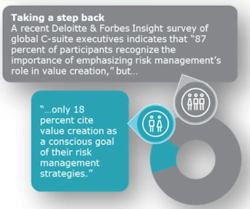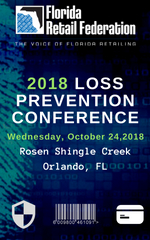|
Heading Off Risks With
Predictive Risk Intelligence
 Across
industries, stakeholders expect risk monitoring to provide intelligence
that supports strategic decision-making. Predictive risk intelligence
could help solve many of the more complex challenges. Across
industries, stakeholders expect risk monitoring to provide intelligence
that supports strategic decision-making. Predictive risk intelligence
could help solve many of the more complex challenges.
Boards, shareholders, regulators, customers, and business partners
increasingly expect organizations to provide a view into what could go
wrong in the future and a real-time view of issues they currently face —
not just insights on what went wrong in the past. Moreover, they demand
organizations demonstrate that they can execute quickly on
risk-management decisions.
Organizations can get an early warning system on emerging risks,
potential loss and risk exposures, and external threats by using
predictive risk intelligence (PRI). With PRI, organizations can enhance
their ability to detect and monitor risks and make more informed
decisions faster.
Advances in PRI are increasingly recognized as cornerstones to effective
risk-monitoring programs. Respondents to the
Deloitte and Forbes Insight Survey reported that risk-management
programs help them increase operational resiliency; realize the value of
new technologies; improve cost effectiveness and accelerate time to
market, among other benefits. That only half of survey respondents
acknowledged that they leverage comprehensive risk
analytics to make strategic business decisions suggests a need for a
more holistic risk-monitoring methodology.
Risk-monitoring Strategies
Risk monitoring occurs throughout the risk-management lifecycle and can
be broken down into three categories:
Reactive Risk Monitoring —The initial monitoring mechanism
through which the organization tracks and reports loss events after they
happen. Process owners may report these incidents as losses occurring
during the normal course of business or discover incidents such as fraud
during an audit or the assessment of a particular business process. The
ability to respond post-event with a remediation plan is central to this
technique.
Integrated Risk Monitoring — A discipline, process, or initiative
that an organization has assimilated with overall
business strategy. It’s the next stage of monitoring that employs
indicators of risk, performance, compliance, and control to report on
risk-performance thresholds. The primary emphasis of integrated risk
monitoring is the timely reporting of risks given identified assessment
criteria, the status of established benchmarks, and interpretation of
risks deviating from performance standards such as organizational risk
appetite.
Predictive Risk Monitoring — A technique that helps organizations
discover potential risks and threats, including types of risk that are
not covered by existing risk indicators. Predictive risk monitoring
applies analytics to current and historical information from internal
and external data sources to identify emerging risks that have a short
cycle time before actual impact.
How PRI Works
PRI can help turn risk, controls, and performance information into
insights, preparing organizations for a more refined understanding of
emerging risks. Such a capability also can help shift risk reporting
from a periodic basis to real-time. Typically, the PRI process would
include the following steps:
- Defining PRI scope: Management and risk governance teams
identify prioritized risk events to better monitor on a continual
basis.
- Identifying precursors of risk events: Each risk
identified within scope is analyzed to identify indicators or
incidents that precede risk events and provide a reliable indication
of the occurrence of an event. For example, a failure in product
quality may result from an internal process failure or a
supplier failure.
- Determining data sources: Each risk event precursor is
prioritized and mapped to internal and external data sources, which
can supply the data required for analysis and predictive modeling
(see chart below for examples of data sources).
- Developing static and self-learning predictive algorithms:
Via an analysis of internal and external precursor information, a
predictive analytics algorithm is selected for fit and applied to
predict or detect the heightened occurrence and likelihood of a risk
event. Data mining and machine learning capabilities allow these
models to evolve with ongoing improvements in accuracy.
- Initiating PRI generation: Risk governance functions
start collecting the baseline data for each risk category and apply
risk predictive algorithms to generate emerging risk alerts and
notifications. The results are continuously evaluated to determine
the models’ success rate and enhance the accuracy of outcomes.
Formal reports are generated to describe the emerging risk
environment for C-suite and board decision-making.
Applying technology across the PRI lifecycle generates faster and
more reliable risk information, while also creating an effective
risk-monitoring process. One example of how technology is applied to
PRI is within data collection, where robotic process automation (RPA)
might be applied to collect data on a real-time basis. With more
data collected over time, risk analysis techniques such as
regression and event tree analysis improve in accuracy.
Another example is within data standardization and aggregation,
where RPA and cognitive intelligence are employed to assimilate,
cleanse, standardize, and aggregate various formats and types of
data. And in predictive risk modelling and analysis,
big data predictive analytics and algorithms are executed by
artificial intelligence and machine learning to put the collected
data and models developed to work. Based on the risks identified,
analytical models interpret outcomes and confirm model parameters to
generate PRI.
In addition, PRI could potentially help to solve complex challenges
across industries. For example, PRI concepts can be applied to
automotive, retail and distribution, and technology companies to
provide actionable risk information on critical infrastructure
components and products, thereby helping to mitigate industrial
technology and operational failures.
Within the financial services industry, where improving
conduct is a priority, PRI could provide intelligence on changes
in employee behaviors indicative of potential conduct lapses,
changes in employee sentiment, and policy breaches that indicate
potential conduct and compliance risks, such as insider trading.
In the life sciences industry, where entities interact with hundreds
of third parties while also meeting strict regulatory requirements,
PRI could use external data sources such as news, government
publications, and publicized incident reports to provide visibility
into third-party operations that often lack transparency.
Industry-wide Benefits of
Predictive Risk Intelligence
Across all industries, stakeholders expect risk monitoring to
provide intelligence that supports strategic decision-making such as
investment in products and technologies, new business models, and
the development of advanced risk strategies.
Using predictive risk intelligence, organizations can develop a
refined understanding of emerging risks to enhance their ability to
avoid situations where high-risk individuals are concerned,
understand the geopolitical climate and countries with a high
perception of corruption, and improve techniques for holding
business accountable for involving both internal and external
relationships in the risk-monitoring process.
Article originally published on wsj.com |

.png)
Top News
The D&D Daily's Publicly Reported Q3 Robbery Report
The D&D Daily's Publicly Reported 'Retail Violent Death Report' Q3
Sears, once the largest U.S. retailer, has filed for bankruptcy
Lowe's CEO Marvin Ellison Talks Emergency Preparedness, Pledges $2M for
Hurricane Michael Relief Efforts

Top ORC Cases
North Haven Man Pleads Guilty in U.S. Court to Role in Large-Scale $5.9M
Fencing Operation
Worchester, MA: Man held on ID theft charges worked at store tied to
$3.6M food stamp fraud
Detroit, MI: Store Owner Pleads Guilty To $2M Food Fraud
Houston, TX: Thieves smash display cases, make off with $2M in jewelry

|



